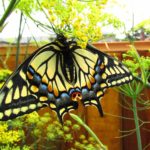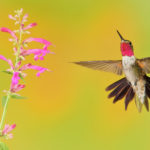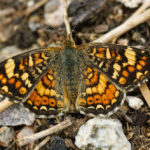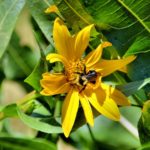Wildflowers abound this time of year, throughout the valley and up amongst the high peaks of the Tetons and Gros Ventres. Alpine prairies provide vivid photo-ops as we hike past vast fields of green, yellow, purple and red. As humans we tend to naturally appreciate these broad vistas but forget that this palette of natural color only exists thanks to a minuscule, but miraculous phenomenon between plants and their animal neighbors. Most of us have heard of pollination, but many of us probably have not looked into what a truly complex and rather strange process it is.
Pollination is a symbiosis, a relationship between living organisms, but more specifically it is mutualism – a symbiosis where both species in the relationship benefit. When insects, birds and even bats land on a flower and drink the nectar provided by the flower, parts of their bodies come in contact with that plant’s pollen, which are essentially the plant’s male reproductive cells. When the pollinator travels to its next nectar source, that animal shakes off some pollen from the previous flower and helps fertilize the female reproductive cells in the new flower. Essentially, the pollinator gets a reliable source of food, the plant gets fertilized, or rather “pollinated.” Seems like an odd way to reproduce, right? Scientists believe that this strange relationship between animals and plants evolved very early in the history of flowering plants, or “angiosperms.” It is also believed that the evolution of pollination quickly enabled flowering plants to reproduce super effectively, thus allowing for rapid diversification of this particular group of plants; partially explaining why angiosperms are today, one of the most diverse groups of living organisms with about 300,000 known species.
- Broad-tailed Hummingbird
- Field Crescent Butterfly
- Bumblebee
Humans still have much to learn about pollinators. Just within the last few decades have we understood the importance these animals have to our existence – studies have shown that 1 out of every 3 bites of food people eat is created by pollinators. Yet many bee and butterfly populations and ranges are still unknown even throughout the United States, although we now know that several are struggling. Bees have been in many headlines lately – “Save the Bees” has become a common tagline. However, with the focus being on non-native honeybees that are not actually threatened with extinction, native bee species that are more efficient and more widespread pollinators are often left out of the spotlight. Many of these species (including a few found in Teton County) suffered estimated population declines of 80-95% due to habitat decline and possible pesticide poisoning.

Anise swallowtail
Today, 33 species of butterflies and moths are listed as federally endangered, and only in the last 3 years have native bees been recognized and listed as being threatened with extinction. All species of pollinators protected by the federal Endangered Species Act can be found here.
There are various field guides and online resources for identifying birds and butterflies throughout Wyoming, but far fewer for less conspicuous insects like bees and beetles. Linked below is a field guide to western bumblebees produced by the U.S. Forest Service and Pollinator Partnership and modified for Wyoming, by the Wyoming Biodiversity Institute, as well as a great article by researchers at the University of Wyoming explaining various types of bees in detail. Most bee species can be difficult to tell apart (even under a microscope), but bumblebees require less of a learning-curve because their identification usually relies on color patterns on different body parts, just like butterflies and birds! Why not extend your wildlife searches to a smaller scale, and challenge yourself to identify pollinators like butterflies and bumblebees?
Additional Resources:
https://wyobio.org/files/2614/1174/2125/printablebeeguide.pdf
http://www.uwyo.edu/barnbackyard/_files/documents/magazine/2016/summer/wynativebees0716.pdf
https://www.fs.fed.us/wildflowers/features/posters/WesternBumblebeesPoster_print.pdf



